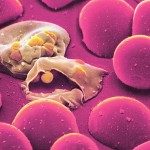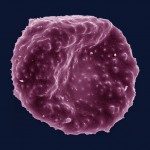Lien vers Pubmed [PMID] – 25916985
Infect. Immun. 2015 Jul;83(7):2771-84
Eukaryotic high-mobility-group-box (HMGB) proteins are nuclear factors involved in chromatin remodeling and transcription regulation. When released into the extracellular milieu, HMGB1 acts as a proinflammatory cytokine that plays a central role in the pathogenesis of several immune-mediated inflammatory diseases. We found that the Plasmodium genome encodes two genuine HMGB factors, Plasmodium HMGB1 and HMGB2, that encompass, like their human counterparts, a proinflammatory domain. Given that these proteins are released from parasitized red blood cells, we then hypothesized that Plasmodium HMGB might contribute to the pathogenesis of experimental cerebral malaria (ECM), a lethal neuroinflammatory syndrome that develops in C57BL/6 (susceptible) mice infected with Plasmodium berghei ANKA and that in many aspects resembles human cerebral malaria elicited by P. falciparum infection. The pathogenesis of experimental cerebral malaria was suppressed in C57BL/6 mice infected with P. berghei ANKA lacking the hmgb2 gene (Δhmgb2 ANKA), an effect associated with a reduction of histological brain lesions and with lower expression levels of several proinflammatory genes. The incidence of ECM in pbhmgb2-deficient mice was restored by the administration of recombinant PbHMGB2. Protection from experimental cerebral malaria in Δhmgb2 ANKA-infected mice was associated with reduced sequestration in the brain of CD4(+) and CD8(+) T cells, including CD8(+) granzyme B(+) and CD8(+) IFN-γ(+) cells, and, to some extent, neutrophils. This was consistent with a reduced parasite sequestration in the brain, lungs, and spleen, though to a lesser extent than in wild-type P. berghei ANKA-infected mice. In summary, Plasmodium HMGB2 acts as an alarmin that contributes to the pathogenesis of cerebral malaria.



